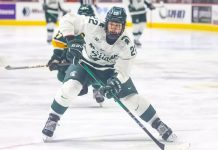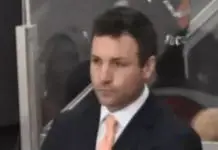No changes to overtime procedures, supplemental discipline or facial protection were made by the NCAA men’s and women’s ice hockey rules committee when they met Monday through Wednesday in Indianapolis.
Rules changes that were forwarded to the playing rules oversight panel included tweaks to established procedures.
“I would say that generally, we dissected our game and ultimately believe our current rules are serving us well,” Tom Anastos, chair of the rules committee and coach at Michigan State, said in a news release. “We continue to work to find ways to improve our game long term, but I would say we’re pleased with where we are right now.”
Changes to overtime, including extending the period beyond five minutes and using a four-on-four format employed by the NHL, didn’t receive much support from coaches.
The committee also declined to make any changes to disciplinary issues such as allowing referees to view video or eliminate automatic one-game suspensions for some disqualification penalties.
Conferences will continue to be responsible for supplemental discipline of their own players.
“I think the awareness that has been raised to this issue is important and significant,” Anastos said. “In meetings with conference commissioners, coaches and coordinators of officials, we believe it is best to continue to funnel reviews of this type as we are now.”
Moving away from full facial protection again was discussed, but the committee did not take action toward implementation of a three-quarters face shield.
“We are trying to be sure we help to collect data from any source that can be compared to NCAA data,” Anastos said. “The process has been challenging, but we will continue to work with leagues that use the shield so we can make an informed proposal if appropriate. We just don’t have enough information at this point.”
A women’s hockey breakout session led to a proposal for an experimental rule that would allow the puck to be played legally at any height.
According to the NCAA, these are the rule changes that will be forwarded to the playing rules oversight panel for its July 16 meeting:
Hand Pass by Faceoff Player — The players taking a faceoff are not allowed to use their hand to play the puck. A violation of this rule will result in a minor penalty, similar to the NHL rule.
Faceoff Procedure — The defending team’s faceoff player shall be required to put the stick down first. Previously, the attacking team was required to do so. Center ice faceoffs will continue to require the visiting team to put the stick down first.
Goal pegs — Ten-inch goal pegs that are anchored into the ice or floor must be in place at all NCAA levels by the 2016-17 season.
Faceoff Location — Offensive Scoring Opportunity: If the offensive team is attempting to score and the puck goes out of play — the faceoff will remain in the attacking zone.
Faceoff Location — High stick/hand pass: In these cases, the ensuing faceoff will be one zone closer to offending team’s goal.
Video Replay — Several changes were made to the criteria and process:
• It is reviewable to determine if a goal was scored before a penalty occurred.
• If an offsides or too many men on the ice penalty is missed and a goal is scored, it is reviewable until the puck leaves the offensive zone. This replaces the previous wording that only allowed the review to occur if the missed play directly led to a goal.
• It was clarified that video review may be used without the restriction of games that are being broadcast on television.
Penalty Shot/Shootout — During a shootout or penalty shot, if the goal becomes dislodged by the goalkeeper, the referee shall either award a goal (if intentional or if the goal was obvious and imminent) or allow the team to shoot again.
Penalty Shot — If a player that is awarded a penalty shot is injured and unable to take the shot, one of the players on the ice at the time of the infraction shall be chosen to shoot.
Look-Up Line — The committee approved the use of a warning-track style line intended to positively impact safety near the boards. The use of this line will not be mandatory, but is permissible.


